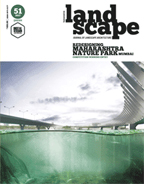Design
Identities and Boundaries | Geeta Wahi Dua
LA 51 |
|
|
|
|
While India has many cultural roots of its own, it can be send to have not simply one, but multiple identities to define it depending on the geographical and cultural context. However, more often than not, our designs do not resonate with our traditional undercurrent in that the subtleties of our culture and the forces of nature are not brought together in perfect sync.
Knowledge and ideas must be place, time and context specific and while we may borrow from, we must not replicate the designs of the West and East for they too are subjective to their context. The objective factors may blur the boundaries of design, but it is the subjective factors that render each design definitive and unique. |
|
|
|
Times change. So do we. Therefore, there are no absolute truths. Every truth is half, made complete with its value in a particular time, specific place and context. Change is the only constant. Travel light.
This profound fact of life can actually guide us professionals in resolving many mental conflicts, ideas regarding identity and self and our role in the larger frame of society. One realizes that many of our pre-conceived notions, perceptions and attitudes which we have stayed with for so long are now outdated and irrelevant. World views need to be updated in every new cultural era, and at every new place and in every new context. Wisdom lies in the understanding of which components will change and which values and principles or which part of the truth is constant.
Western versus Oriental
In the past, there have been erudite deliberations by experts, thinkers, designers and policy makers on the idea of identity. In recent times, the idea of Nationalism has again caught a larger imagination with people and political leaders. Many political parties in India are taking pride in the ancient tradition of the Vedas and crediting classic epics as the supreme source of applied science, much before Western civilizations invented it. There are debates and discussions about separate identity of each State.
|
|

| |
|
|

|
| ISSUE NO: 51 |
|
 |
|
exhibition
ArvindTalati: A forgotten pioneer of Modern Indian Architecture
reports
IGBC's Green Landscape Summit 2016
Changing Climates, Evolving Landscapes, Isola-Goa 2017
Landscape and Conservation, SKNCOA-Pune, 2017
public participation
Public Participation in Design Works:
The Nimby, Banana and Lulu Syndromes
Harshad Bhatia
learning from the past
Clues on Street Network from Manasara:
Footpath or Sidewalks are not a British Legacy to India
Archana Sharma
directions
Going Forward: Landscape Architecture in India
Alpa Nawre
view from within
Identities and Boundaries
Geeta Wahi Dua
profile
Aesthetics, Utility and Environment: Practice of Ravi
Varsha Gavandi, Pune
competition
Redesigning Maharashtra Nature Park, Mumbai
landscape design
Transforming Urban Landscapes: Futala Lake, Nagpur
Deeproots Design
Revitalisation Of Derelict Urban Spaces:
Bundh Rejuvenation and Eco-Restoration of Urban Forest, Gurugram
VSPB Associates
Mana Resort, Ranakpur, Rajasthan
Parul Kiri Roy
Swastik Vatika: Marriage Venue, Anand
Karmavir Ghatge & Associates
Clover Fields: Weekend Home, Bangalore
Genesis Architecture
seeing the unseen
Panchtattvas: The Road Ahead
Dilpreet Bhullar
book review
An Inspiring Visual Reference
Book: #91 Residences Contemporary Indian Houses #3
review by Madhu Pandit
A Post-Colonial Paradigm of Universal Interest
Book: Cultural Landscapes of South Asia:
Studies in Heritage Conservation and Management
review by Narendra Dengle
landscape industry
Outdoor Lighting
Steve L. Aries
|
|